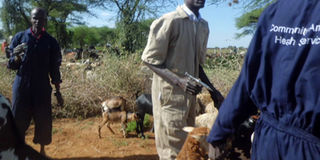
Community vets in Karamoja immunise animals. With better vaccines being devloped, it will be possible to vaccinate livestock against various disease with a single dose. PHOTO BY LOMINDA AFEDRARU.
Developing vaccines using biotechnology
With livestock farmers in Africa still being challenged by diseases, scientists are finding ways to provide effective solutions.
BY Lominda Afedraru
[email protected]
Agricultural scientists in different parts of Africa have been engaged in application of biotechnology mainly for developing improved crop varieties. Now, they are including livestock in their focus by developing animal vaccines through biotechnology.
This has been taken on by scientists in South Africa. They have been conducting research to develop vaccines for five diseases that animals in Africa are prone to.
Huge impact
In Uganda, there are a number of vaccines imported by the government to be supplied to farmers. But they are developed using conventional mechanism; this include foot and mouth trivalent and bivalent vaccine, rabies vaccine, and Brucellosis F19 and East Coast Fever vaccine, among others.
Infectious diseases have a huge impact on food security not only by causing animal death but loss of animal ingredients like milk, which is a basic food for children.
This was pointed out by Dr Lorne Babiuk, from University of Alberta, in a paper on novel livestock vaccines, he presented during the Fifth African Green Revolution Forum held in Addis Ababa, Ethiopia.
Resistance to disease
His team is collaborating with scientists from South Africa in developing vaccines using biotechnology to curb five animal diseases: Lumpy skin disease, goat pox, sheep pox, rift valley fever and peste des petits ruminants’ animal disease.
‘’We are using modern biotechnology to come up with genetically modified animal vaccines, which are both life-saving and cure vaccines, but taking a gene from the animal virus and stacking it into another virus to get a vaccine with resistance for a specific disease,’’ Dr Babuik said.
He further explained that, at the laboratory level, scientists may remove a lumpy skin virus using a specific enzyme and stack it to a small pox virus. Then remove rift valley fever virus, which is stacked to the small pox virus. This will lead to a vaccine that causes resistance to both small pox virus and rift valley fever.
Handling control
This may take a scientist two weeks to one month to conduct the laboratory tests for a resistant vaccine. So far, the team has come up with three vaccines for lumpy skin, sheep pox and goat pox viruses.
However, the team is faced with the challenge of rolling out these vaccines to the farmers due to a lack of regulatory framework in most African countries,
It is requirement that to commercialise a genetically modified product in any country in the world, there should be an existing biotechnology and biosafety law in that particular country.
In Uganda, the team at National Livestock Research Institute (NaLIRRI) is concentrating on research work aimed at handling control of diseases such as the East Coast Fever.
Cause immunity
It is on evaluation of tick proteins that have been developed in universities in Brazil and Cuba, among others, for possible efforts using these proteins to develop vaccine within the country and research work on the foot and mouth disease, which is the most dangerous to animal health at the moment.
Dr Halid Kirunda, the programme leader, Livestock Health Research, says the team at NaLIRRI is mainly conducting research on vaccines developed elsewhere using conventional means to establish if they can work well with the animals here.
These vaccines are usually developed from organisms which cause the disease and what scientists do is to suppress the organism in order to cause immunity in the animals against that particular disease.
Developed locally
Other vaccines the team is conducting experiments on include the recombinant glutathione S-transferase vaccine commonly known as GST, which is made out of bacteria against tick-borne diseases.
According to Dr Kirunda, the only vaccine that is being developed in Uganda, at Uganda Industrial Research Institute, is the Kukustar vaccine, which used to vaccinate chicken against new castle disease, by Brentic Vaccine Ltd.
This type of vaccine is able to stay outside a refrigerator for three days before it expires compared to other imported vaccines that need to be kept under freezing temperatures.
It is the contention that developing animal vaccines using modern biotechnology is welcome because there are certain animal diseases, which are failing to respond to vaccines that are or were developed using conventional means.




